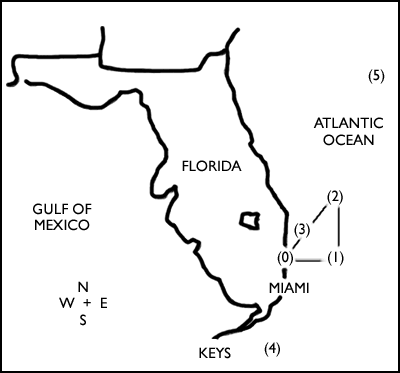Flight 19 - The 'Lost Patrol'
Created | Updated May 28, 2017

Lots of people heard the spooky story about Flight 19, the so-called 'Lost Patrol', when five fully-manned planes vanished from out of the blue in the - insert Twilight Zone theme here - Bermuda Triangle. Never heard of this? Well, here comes a small compilation including some of the most common theories around this story1:
The 'Bermuda Triangle' Version
On 5 December, 1945, a sunny day, five fully equipped and thoroughly checked planes depart from Naval Air Station Fort Lauderdale, Florida, on a patrol mission. All pilots are highly experienced. Suddenly, the formation loses radio contact with the ground station - as if their radios are being jammed. The conversation between the pilots, however, can be followed from the ground station. The pilots sound confused, and seem to have lost the orientation. One of the crew is heard saying 'Everything looks strange, even the ocean.' Then after some more confusion the last message from 'The Lost Patrol' is heard: 'It looks like we are entering white water...we're completely lost.'
A few minutes later, a Mariner rescue airplane is sent to the last estimated position of Flight 19. It checks with the tower ten minutes after departure and is never heard from again. The Coast Guard and Navy fine-comb 700,000 square kilometres for five days and find calm sea, sunny skies and no wreckage or oil-films or anything. The Navy Board of Inquiry reports they are 'not able to even make a good guess'.
A Good Guess
Strange things happen. Coincidences happen. Strange coincidences happen. This story alone is obviously no evidence for alien abductions, supernatural sub-quantum-time-loop-fields or obscure Soviet technology. In the end it's all about how a story is being told, which bits get bent a bit and which bits get omitted. Readers who like to believe in supernatural conspiracy theories may want to skip the rest of this entry, because it is known in good detail what happened to Flight 19.
What's with this 'Bermuda Triangle'?
There are some regions around the globe where the magnetic field shows anomalies, so that a compass points some degrees away from magnetic north. This is a well-known and cartographed phenomenon known as compass variation. There are two regions where this effect is particularly pronounced, one of which is the area known as the 'Bermuda Triangle', southeast of the Florida peninsula2 (the other one is in the Chinese Sea). In this region the compasses point to 'true', or geographic north3.
There are many legends about mysterious catastrophes taking place in this region, or at least attributed to the 'Bermuda Triangle'. Depending on the author, the Bermuda Triangle can be any region in the northern Atlantic. Anyhow, most of the cases date from times before the advent of radio communications and satellite navigation. Usually, in these reports, a ship is lost without a trace or is found completely abandoned. It is also well-known that this region is effected by unstable weather patterns, and storms can build up in a matter of hours.
Flight 19's Flight Schedule
The flight's schedule was as follows:
Legend:
(0) NAS Ft.Lauderdale. Depart 26°03'N 80°07'W heading 091 (T).
(1) Fly course 091 (T), 90km to Hen and Chickens Shoals (1)
(1) Bomb training. Turn Heading 346, fly course 117km to (2)
(2) Turn Heading 246, 193km to (3) then back to (0)
(4) Assumed wrong position
(5) Possible crash site

The weather on the 5 December, 1945 was certainly not excellent - it was cloudy with scattered rain showers. The visibility ranged from 16 to 19 km, and from 9 to 13 km in the rain showers. The sea was moderate to rough, the ground wind speeds ranged between 20 and 32 knots (40-60 km/h). Excluding the rainy bits, the weather was rated 'average' for this type of training mission. The weather got a lot worse towards the end of the day, and even worse in the following two days.
The Avengers (Grumman TBM Avenger Torpedo Bombers, three-men crew) used by Flight 19 are relatively big single-engine propeller aircrafts. It might be worth noting that Avengers are difficult to land on water and sink in a matter of minutes. The Avengers of Flight 19 were in acceptable flight condition. However, it was not unusual to find the instrument board with missing clocks (pilots often removed the clocks as a souvenir, because each had their own wristwatch) or malfunctioning compasses.
Flight 19 was to execute an 'advanced over water navigation problem' and practice some bombing. Except for the instructor of the group, (Lieutenant CC Taylor) all of the crew were in their training phases - advanced, but certainly not experienced, as claimed in many of the 'mystery versions'. Furthermore, this was Taylor's first training flight from Fort Lauderdale - he had been a flight instructor in Miami and had just arrived in Fort Lauderdale. Therefore, he was not very familiar with the region.
So, what happened?
On the 5 December, 1945 at about 2.00pm the five Avengers (14 men altogether) took off from the US Naval Air Station of Fort Lauderdale, Florida, on their training flight: this was Flight 194. After the first part of the training mission at about 4.00pm the group had lost the orientation due to the bad weather conditions and probably defective compasses in the leading airplane.
The instructor noticed the problem with the compasses, but was not sure about the other planes' instruments. There was communication with ground stations and with another plane about the problem. Lieutenant Taylor on one occasion said that he had recognised one island and that he was sure to be flying over the Florida Keys. This was probably the crucial mistake, as he decided to head north to the Florida peninsula. The weather was getting worse and the sun was setting - also, radio contact to ground stations was fading. The real position of Flight 19 was, however, north of Bermuda. This position has been reconstructed from the ranges of the radio stations and the point in time when the group lost contact to certain ground stations. By flying north they were therefore flying away from the continent into the Atlantic ocean. Ground stations, radar stations and ships knew the approximate position of Flight 19 and it was possible to follow their conversations; however, all attempts to establish contact with Flight 19 failed. The group was obviously getting increasingly nervous. At some point the group ran out of fuel and had to land their planes on the rough sea.
Appropriate rescue measures were taken, two rescue aeroplanes (Martin PBM Mariner flying boats with 13-men crew) started even before the contact to Flight 19 broke down. One of these aircraft was lost during this operation. There were two independent witnesses for the PBM Mariner crash - additionally, two water samples from the crash site developed an oil-film. Debris was not found as the sea was very rough. The search for debris of the Mariner and of Flight 19 continued for two days and was terminated due to unfavourable weather. It took a while before the entire incident could be elucidated in most details, mainly based on the radio conversations. In the meantime it looked like something spooky has happened - once more - in the Bermuda Triangle...
Conclusion
While some people will only accept the plausible version when some wreckage is found, most people will find that the incident was a result of unfortunate circumstances: students lose orientation, confront adverse weather conditions, have malfunctioning compasses and the leader of the group makes a bad decision. Also, the absence of debris is not improbable, considering the described weather conditions.

